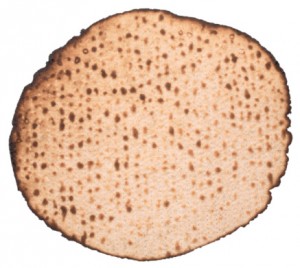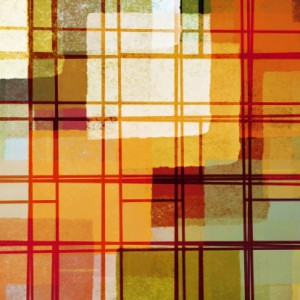Four Existential Questions (Part 3)
By Asher Crispe: May 11, 2012: Category Decoding the Tradition, Inspirations
I remember an episode a few years ago when, standing in the check out line of a grocery store in Brattleboro, Vermont, a person came up to me and asked: “Excuse me Rabbi, what is the name of those crackers you eat on Passover?”
 Matzah, or unleavened bread, bears a little comparison to a giant cracker I suppose, but it might also be cross listed as an underachieving pita or extremely thin pizza crust. Yet despite the resemblance, matzah is unlike any of these things. The key element in the identity of this ‘impoverished bread’ derives from the immediate baking of the dough so that it has no time to rise. Baking it in a minimal time interval in accordance with Jewish law [we should note that there are many other factors and requirements not specified here] means that the dough remains flat and may form a slightly concave shape in baking.
Matzah, or unleavened bread, bears a little comparison to a giant cracker I suppose, but it might also be cross listed as an underachieving pita or extremely thin pizza crust. Yet despite the resemblance, matzah is unlike any of these things. The key element in the identity of this ‘impoverished bread’ derives from the immediate baking of the dough so that it has no time to rise. Baking it in a minimal time interval in accordance with Jewish law [we should note that there are many other factors and requirements not specified here] means that the dough remains flat and may form a slightly concave shape in baking.
So what is dough symbolic of?
In Kabbalah, we speak of the chomer hahiyuli or amorphous substance that serves as the material cause for all created objects in the universe. Everything that we encounter is comprised of a form or pattern that is applied to formless substance which then con-forms to it. This abstract material or substance by itself retains the potential to morph into any shape. Thus the molding of the dough may be likened to a kind of prototyping or provisional impression of form. As all bakers know, the dough may be reshaped time and again as long as the dough has not been baked, much like potters’ clay before it is placed in the kiln. The baking itself constitutes the complete contraction of the form which now becomes bound to the substance in a manner that is not easily undone.
In both Jewish mysticism and in many currents of ancient world philosophy we find an interesting analogy with marriage. In fact, all male/female dynamics in the Torah are sometimes read by the kabbalists in terms of form and matter relationships. In Kabbalah we speak of mochin d’abba (the mentality of father) and mochin d’imma (the mentality of mother) or sometimes just the masculine and feminine as related to abstract pattern or form and substance or matter. Without exploring it fully now, we should nonetheless note that the assignment of these figural terms can sometimes be the reverse in Kabbalah. Nonetheless, the general configuration marks the masculine or father image as the pattern or form and mother as a material substance. Well embedded in Western civilization, the Latin etymology wherein pater gives us both father and pattern while mater yields both mother and mater, buttresses this idea.
So our story now becomes one of the courtship and marriage of form to substance. The shaping of the dough prior to baking compares to an engagement (erusin or kiddushin) while the actual marriage ceremony (nissu’in or chupah) and union of the couple corresponds to the baking. Perhaps we might understand the Chassidic custom that some have of keeping the engagement time to a minimum and proceeding immediately to the wedding as the equivalent of baking the matzah before the dough has a time to rise (i.e. a potential deforming of the relationship).
In short, matzah represents the grafting of minimal form to basic substance. The process of making it happens so quickly that it cannot come from something old. Therefore, Rabbi Levi Yitzchak of Berditchev (1740-1809) understands the matzah as a manifestation of temporal novelty and the Divine process of continuous recreation, something from nothing, at each moment. So too, the classification of chametz or the leavened bread he relates to the word chimatz meaning “delay.”
The implication in the Talmud (Sanhedrin 35a) is that one who reserves judgment—or delays judgment—by allowing the matter to persist undecided for some time represents a praiseworthy judge. The decision to convict must be delayed overnight (somewhat like one who says “let me go home and sleep on it”) so that the judgment not be hasty. The truth takes time to decipher. Similarly, chametz, as we have understood the word related to the maturation of judgment, may be shifted into the context of dough which is left alone for a certain period of time prior to baking. Any postponement in baking the dough means that it has persisted in this state excessively. It has become something old. Matzah by contrast must always be from fresh dough. There can be no time to rise. No delay. As a result the nature of its existence is conditioned by temporal factors. Being and time are entangled.
Extending this way of thinking to all substances or objects of our experience that persist, whose being seems to be old, we run into the Aristotelian view of a primordial universe. What is here has always been here and always will be here. All matter and energy are conserved. Nothing is new. Perhaps the oldest matter can be seen being baked time and again in stellar ovens. ‘There is nothing new under the sun‘ (Ecclesiastes 1:9) addresses the sun as a recycling machine of cosmic proportions. Matter turns to energy and then back to mater in a fusion bakery but there is no new matter or energy. This ‘conservative’ outlook on the universe all ‘under the sun’ practically denotes being under the jurisdiction of the sun. The verse says nothing about that which is above the sun i.e. the existence of a transcendent source that permits continuous recreation. The sun represents only creation of something from a pre-existing something, not something from nothing.
 Today science has started to move above and beyond the sun. We now have an understanding of a phenomenon known as virtual particles which emerge out of the quantum vacuum. They emerge as something from nothing, pulsating in and out of existence continuously. Moreover, they can interact with ordinary particles. What this amounts to is an acknowledgement that the substrate that the universe is built upon is dynamically changing. It is always new. Just as the images on one’s computer screen or television monitor are constantly refreshing, so too the universe itself undergoes this incessant interruption and reconstruction. Imports and exports abound in an open universe.
Today science has started to move above and beyond the sun. We now have an understanding of a phenomenon known as virtual particles which emerge out of the quantum vacuum. They emerge as something from nothing, pulsating in and out of existence continuously. Moreover, they can interact with ordinary particles. What this amounts to is an acknowledgement that the substrate that the universe is built upon is dynamically changing. It is always new. Just as the images on one’s computer screen or television monitor are constantly refreshing, so too the universe itself undergoes this incessant interruption and reconstruction. Imports and exports abound in an open universe.
Matzah encapsulates the extraordinary nature of the world. The limit-experience embodied by Egypt takes the Aristotelian perspective of an ordinary world that is fixed and unchanging and fashions from it a prison for our minds and bodies. A person can fall victim to the false consciousness of appearances illuminated by the sun and all that it symbolizes. Here, the root of all exile begins with buying into the persistence of a self-same world and the unwarranted submission to unchanging limits of reality. No slave to this perception has ever escaped unaided. If we believe that this is our world and there is no changing it, or that it will always just be more of what it already is, we have drowned in the egyptification of reality.
Known for their ‘book of the dead’, the ancient Egyptians viewed substance as persisting and attempted to have it endure in a specific form. Extending beyond the Pharaohs, the mummification of nature lies at the heart of this conflict of civilizations. God taking us out of the constricted consciousness of Egypt, amounts to our facing the prospect of a universe which is not primordial. Creation occurred like a big bang. Only we cannot stop there. It continuously reoccurs at each and every moment. No delay or interval of time can be found wherein an existent can experience inflation. We cannot build something from something to give rise to complex beings because we have no time to accomplish this. We only have minimal being and bare existence as exemplified by the matzah.
By way of allusion we find the letters of the Hebrew word MaTZaH (מצה) to be a poetic contraction or notarikon (Greek for ‘shorthand’ or notation) for MiTZiut hadashaH or new reality (מציאות חדשה). Passover, as the holiday of the spring where new and previously undetectable growth sprouts out of the ground, illustrates the concept of emergence. The shift can happen in a moment. New realities spontaneously emerge. This is our food for thought that reflects the ‘consumption’ of time.
Calling matzah the bread of poverty, which is also the bread liberation and redemption, can now be appreciated. Poverty obviously implies few if any processions. On an existential level, the unvarnished facticity of our existence has little by way of description. If we take adjectives as riches, properties and attributes as assets, then the matzah truly is poor and nondescript. Perhaps we could borrow an expression from the dialogue of two twentieth century philosophers, Maurice Blanchot and Emmanuel Levinas, for whom minimal being and bare existence present with the simplicity of the expression “there is” or il y a in French. Matzah epitomizes the ‘there is’ of reality that is elementary, pure and surprising.
 Eating matzah, internalizing the consciousness of the renewal of reality through continuous creation at each and every moment compels us to ask: why is there sometime rather than nothing? Or: why was the world created? Forget the richness of life—the expansive orders of reality that have so much attributed to them—why is there anything at all?
Eating matzah, internalizing the consciousness of the renewal of reality through continuous creation at each and every moment compels us to ask: why is there sometime rather than nothing? Or: why was the world created? Forget the richness of life—the expansive orders of reality that have so much attributed to them—why is there anything at all?
Cosmology, whether scientific or mystical in its bent (and many are starting to acknowledge that it’s both) grapples with the question of the matzah. Hopefully this is done in a manner whereby the question can be fruitful and multiply many generations of response.
In the next article we will take up of the question of the maror or bitter herbs.
http://www.interinclusion.org/inspirations/four-existential-questions-part-2/
Four Existential Questions (Part 3),






















;)
;)
;)
;)
;)
;)
;)
;)
;)
;)
